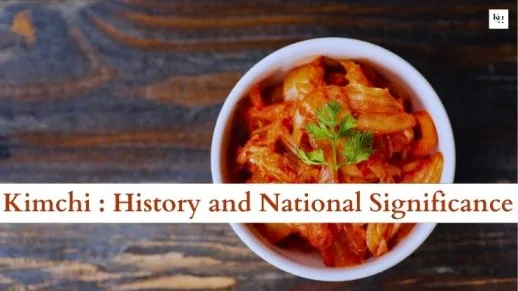
The National Dish of South Korea and its Significance : Kimchi
Everything you need to know about the National dish of Korea
Wassup Culture Explorers,
If you have already read our blog on the traditional drink of South Korea ‘Makgeolli : A Pot Full of Clouds’ then you are already aware of how the Koreans never back off in expressing their love to become tipsy similarly they never back off when it comes to indulge their taste buds in feisty cuisine.
Among yangnyeom, buldak, galbi, Jjambbong, bibimbap, ramyeon, hot dogs, fried rice, pancakes, cocktails and braises, Kimchi is a Korean dish which versatility surpasses all food combinations of the dynamic Korea.
It is a dish that is not only a regular meal in every Korean household but also is a symbol of elders’ love towards their children. So, next time when you see a Korean visiting home after a long time or returning from home, don’t be surprised if they come back with bags of Kimchi with them.
As meaty the taste is, so do the stories revolving around this dish and today I decided to reveal some of the juicy secrets that made Kimchi a National dish of South Korea.
The term Kimchi is accepted both by North and South Korea. However in earlier times it was referred as timchae and over the period of palatalization the sound modified to Kimchi.
timchɑi (팀ᄎᆡ;) > dimchɑi (딤ᄎᆡ) > jimchɑi (짐ᄎᆡ) > jimchui (짐츼) > gimchi (김치)
Kimchi is considered as a korean banchan (side dish) which consists of a myriad of ingredients and is often personalized according to the consumer’s taste. The most commonly used ingredients include salted and fermented vegetables such as napa cabbage or Korean radish, a variety of seasonings such as gochugaru (Korean chili powder), jeotgal (salted seafood), spring onions, garlic and ginger. A hundred types of different Kimchi can be made altering the vegetables and can also be consumed with soups, stews, noodles and as a classic pickle with almost every Korean meal.

The winter Kimchi also known as Kimjang is a popular traditional kimchi which is prepared every winter by Korean households and is stored in large earthenware fermentation vessels called onggi. These earthenware were then kept underground during the winter to prevent it from freezing and to delay the fermentation process during summer heat. Special terraces called Jangdokdae were also preferred in preserving this savory item but in modern times Kimchi refrigerators are a staple appliance in Korean households.

Although the taste of Kimchi can be defined as spicy, savory, acidic and umami flavored, as garlic and chili pepper act as standard ingredients, historical records do not mention these spices in preparation and thus Kimchi used to be not spicy at all. The 17th and 18th century recipe books mention the use of chili peppers in Kimchi; however being a new world crop it did not gain recognition until the 19th century. Early 19th century recipes closely resemble coming of age Kimchi recipes and traditional Kimchi varieties including radish kimchi and cucumber kimchi.
A 13th century Goryeo scholar has also written a poem describing how the process of Kimchi preparation helps in bonding families.
Pickled radish slices make a good summer side dish,
Radish preserved in salt is a winter side dish from start to end.
The roots in the earth grow plumper every day,
Harvesting after the frost, a slice cut by a knife tastes like a pear.
~ Yi Gyubo [Translated by Michael J Pettid. In Korean Cuisine an Illustrated History]
The Korean banchan Kimchi also holds records as being a crucial food for the Korean troops during the Vietnam war. Also in 2008 scientists invented a special low in calorie, vitamin rich space kimchi for the first Korean astronaut Yi So Yeon. The programs developed by South Korea for adult Korean adoptees to learn about their own culture involves activities like making Kimchi with other fellow Koreans.
In 1996 when Korea protested against Japan clarifying that Kimchi is a completely different food item and is not similar to Japanese food item Kimchui as the preparation process varies wildly. The neighboring country North Korea also came up with its unique twist to Kimchi preparation.
During drastic climatic change and heavy rainfall the production of Kimchi became slim for which many restaurants stopped serving Kimchi as a free side dish which The New York Times compared to an American Hamburger restaurant no longer offering free ketchup. Later, the United States, California, Virginia, Maryland and New York along with the capital city of Washington D.C. declared 22nd November as ‘Kimchi Day’ to signify the importance of this dish as a part of Korean culture.
In 2017, China boycotted Kimchi in its markets and vowed to never consume it because South Korea accepted the deployment of THAAD, an anti ballistic missile that shoots down targets at a short, medium and intermediate range with a hit to kill approach. They even claimed that Koreans modified the Chinese recipe of pao cai and termed it as their national dish.
Later the Global times explained that it was a simple misunderstanding as their Chinese articles used the term pao cai but the English translation erroneously changed it to Kimchi rather than pao cai. When the dispute was dissolved the Korean government came up with a chinese name to promote Korean culture in the Chinese markets with the name ‘xīnqí’ but Chinese people complained and assured that they can easily pinpoint the differences between pao cai and Kimchi and hence there is no need to make a new word popular.
Ingredients and Seasonings Used In Kimchi
Kimchi Ingredients and Kimchi Seasonings vary as per the seasons. Hence each of the quartet seasons of Korea have a unique flavor of Kimchi to offer. Most commonly used ingredients in traditional Korean Kimchi are:
| NON VEGETARIAN INGREDIENT LIST | VEGETARIAN INGREDIENTS LIST |
| 2 heads of Napa Cabbage, 1 ¼ cups of coarse Sea Salt, 2 tablespoon glutinous rice flour or Plain flour, Fish sauce, 1 cup radish, chopped, 5 green onions, chopped, 5 garlic chives (optional), Minari leaves (Water Parsley, optional), 1 medium sized carrot, Fermented shrimp (optional), 1 medium sized white onion, chopped, 5 to 6 cloves garlic, pressed, 2 tablespoons of white sugar, 1 teaspoon ground ginger, 5 tablespoons of Gochugaru (Korean Chili powder), Sesame Seeds (optional) | 2 heads of Napa Cabbage, 1 ¼ cups of coarse Sea Salt, 2 tablespoon glutinous rice flour or Plain flour, Vegetable stock, 1 cup radish, chopped, 5 green onions,chopped, 5 garlic chives (optional), Minari leaves (Water Parsley, optional), 1 medium sized carrot, 1 medium sized white onion, chopped, 5 to 6 cloves garlic, pressed, 2 tablespoons of white sugar, 1 teaspoon ground ginger, 5 tablespoons of Gochugaru (Korean Chili powder), Sesame Seeds (optional) |
METHOD
Step I: Brining:
- Take a large container and place two freshly washed cabbages.
- Slice it vertically into two pieces making a slit at the bottom of each one or dice it into big cubes.
- Add an ample amount of coarse salt covering each leaf and set it aside.
- Turn it over after every 30 minutes to evenly salt the cabbages.
Importance: This step will drain out the excess water from the cabbage making it less susceptible to be ruined during fermentation.
Step II: Kimchi Base:
- In a container take 2 cups of plain water or one cup of vegetable stock.
- Add 2 tablespoons of sweet rice flour or 2 tablespoons of plain flour and stir it well.
- Cook it under medium flame while stirring it for 2 minutes continuously.
- When the base thickens and bubbles can be seen, add 1 tablespoon of sugar in it.
- Stir it well for 1 to 2 minutes till it becomes thinner.
- Remove it from the heat and set it aside.
Step III: Preparation of Vegetables:
- Cut 1 cup of thinly julienne sliced radish.
- Slice the green onions diagonally.
- Chop the garlic chives and 1 cup of Minari leaves (optional).
- Cut one medium sized carrot into thin julienne slices.
Step IV: Seasoning
- In a mixer grinder or vegetable crusher add 1 medium sized chopped onion.
- Add 1 teaspoon of peeled ginger
- Add crushed garlic cloves (according to own preference)
- Add the prepared Kimchi base to it
- Add half a cup fish sauce or 1/3 rd cup Vegetable stock
- Grind it into a fine paste.
Note : If you are using vegetable stock instead of fish sauce then add 3 tablespoon salt to it along with 1 teaspoon sugar with the vegetable stock.
Step V: Blending
- In a medium sized bowl, transfer the grounded paste and add Gochugaru (Korean red chili powder) to it.
- If you prefer spicy flavored dishes 1 full cup of red chili powder will be good and half a cup for people who prefer milder taste.
- Add the chopped fermented shrimps to it. (optional)
- Whisk it to blend the flavors evenly using a spoon and set it aside. (No need of using a grinder, blender or electronic whisker)
Step VI: Kimchi Preparation.
- Don’t forget to turn the cabbage and press it to squeeze the water after every 30 minutes. The cabbage leaves will become softer with a lot of salt water drained out in the bowl indicating that it is ready to use.
- This process usually takes 4 to 6 hours in general and depends on the quantity of cabbages used.
- When the cabbage is ready, wash it thoroughly under running water for 3 times to get rid of the excess salt.
- Transfer the cabbage into a large bowl and wear plastic or rubber gloves to start preparing the Kimchi.
- Spread the paste on each cabbage leaves till it is covered fully and then transfer it into an airtight container or earthen crockware.
Note: The Korean Chilli powder or raw Red Chilli paste might make your palms burn. So it is recommended to wear gloves to protect it from skin irritation. This process also helps in keeping the Kimchi hygienic from possible hand bacterias.
Step VII: Preservation
Keep it in the refrigerator untouched for 2 to 3 days. When a pungent sour smell starts to come out, serve it with your favorite dish sprinkling some sesame seeds over it as dressing.
Importance of preserving: If you keep the Kimchi outside, the room temperature will speed up the fermentation process making it easily ruined within a couple of days. Due to the unpredictable weather, South Koreans prefer storing them in Kimchi refrigerator with custom temperature settings.
The more days you keep the Kimchi, the stronger the sour odor will become. Homemade Kimchi can be stored for at least 1 month if refrigerated carefully. Store bought unopened Kimchi can last up to 3 to 4 months or longer depending on the preservative used by the individual company and refrigeration process preferred by the consumer.
The steps and processes explained are based on how the famous Korean Youtuber ‘Maangchi’ suggests. If you would like assistance as you prepare your Kimchi, you can definitely check out ‘Maangchi’s easy to make Kimchi Video recipes on Youtube.
Kimchi Varieties
Kimchi is globally recognised as a spicy fermented cabbage dish that is seasoned with freshly plucked vegetables, authentic spices and coarse sea salt. It is a staple dish in Korean cuisine that is served either as a side dish (banchan) or as a main dish.
Depending on the season and harvest availability of the northern and southern regions of Korea, different seasons have a different set of Kimchi to offer. The most popular Kimchi varieties are:
- Baechu Kimchi (배추김치) spicy napa cabbage kimchi made from whole cabbage leaves.
- Baechu Geotjeori (배추겉절이) unfermented napa cabbage kimchi
- Oi Sobagi (오이소박이) cucumber kimchi that can be stuffed with seafood and chili paste.
- Pa Kimchi (파김치) spicy green onion kimchi.
- Yeolmu Kimchi (열무김치) made with yeolmu radishes while not necessarily requiring fermentation.
- Gat Kimchi (갓김치) made with Indian mustard.
- Bossam Kimchi (보쌈김치) Kimchi Wrap.
- Nabak Kimchi (나박김치) a mildly spicy watery kimchi.
- Baek Kimchi (백김치) white kimchi, made without chili pepper.
- Kkakdugi (깍두기) made with spicy korean radish with fermented shrimp and have a strong odor.
- Yangbaechu Kimchi (양배추 김치) made from headed cabbage leaves and have a spicy taste.
- Dongchimi (동치미) A non spicy watery Kimchi made of white korean radish and napa cabbage along with green onions, korean pear etc.
- Chonggak Kimchi (총각김치) spicy Kimchi made with cubed ponytail radish.
Seasonal Preference
The Korean quartet set of seasons not only offer picturesque landscapes but also Kimchi varieties made with seasonal crops. Here are the types of Kimchi preferred by Koreans as per seasons.
Winter
Winter is considered as the prime Kimchi season, since from the traditional days housewives gather together to help each other making Kimchi for their household. Different varieties of Kimchi are prepared due to the favorable low temperature that act as a boon for preserving the Kimchi.
The traditional method of preserving Kimchi in earthen pots burying them in the ground is known as Kimjang (김장). Hence the Kimchi stored can also be called as Kimjang Kimchi (김장 김치). Nowadays well equipped restaurants and modern stores use Kimchi refrigerators designed specifically to store winter Kimchi with temperature controls to preserve winter kimchi for longer periods.
November and December are the peak months of preparation and Baechu Kimchi i.e Kimchi made with napa cabbage, thin strips of korean radish, chestnuts, pears, red peppers, pine nuts, parsley, garlic, ginger and manna lichen( a rock tripe fungi) along with Dongchimi (동치미), a non spicy watery Kimchi made of white korean radish and napa cabbage along with green onions, korean pear etc are preferred.
Spring
When the snow bed of Korea gets replaced with colorful petals, Koreans celebrate the homecoming of bees and butterflies by indulging their taste buds with Kimchi made with fresh leafy green vegetables. Spring Kimchi is not preserved for a longer time and is eaten fresh. Pa Kimchi (파김치) spicy green onions kimchi and Yeolmu Kimchi (열무김치) radish kimchi is a popular choice of Kimchi in spring.
Summer
Apart from Yeolmu Kimchi, the summer in Korea also offers Kimchi made with cucumbers Oi Sobagi (오이소박이). Summer Kimchi is stuffed with seafood. Shellfish, fermented fish, and dried chili peppers are the most preferred ingredients. During the 3 hottest day of Korea (Dog Days) Kkakdugi (깍두기) made with spicy korean radish with fermented shrimp is served as a crucial side dish of Samgyetang (Korean Ginseng Chicken Soup).
Autumn
To match the colorful mood of South Korea, Autumn offers the goodness of blended stuffing in Baechu Kimchi. Prepared by inserting authentic stuffing made of salted anchovies and dried shrimps between layers of salted leaves of a whole Napa cabbage. The fillings can differ according to area, availability of items and preserving procedure based on weather conditions. It often emits a strong salty flavor due to the anchovies and shrimps.
Check Out: The Korean Seasons | A Different Perspective on the Four Seasons
Popularity Preference by Koreans
Baechu Kimchi is the most popular kimchi in Korean markets. Other than Baechu , Kkakdugi, Dongchimi and Chonggak Kimchi are preferred.
How it is Eaten
Kimchi can be eaten raw, as a side dish with rice or mixing it with soups, stews and preparing new items like Kimchi with noodles, Kimchi fried rice, Ramyeon Kimchi etc. The versatility of this dish can be put into use as per the consumer’s liking. Traditionally it was eaten as a side dish with rice but in modern times Kimchi fried rice (김치볶음밥), Kimchi soup (김칫국) and Kimchi stew ( (김치찌개) are well liked by the new generation.
Kimchi can also be made using sweet potato stems known as Gogumasoon and another admired Kimchi infused dish sought after by many is the Army base stew Budae Jjigae (부대찌개) prepared with spam, sausage and kimchi. This stew was developed to keep soldiers well fed when Korea suffered from shortage of food during wars.
National Significance
Kimchi has been a dish that is born when Korea is an unknown mountain cut region to the world. For years it has been seen as a delicacy that unites families irrespective of their status, health and wealth.
In ancient times Koreans used Kimchi methods to preserve and eat fresh vegetables during colder months which eventually turned into a social practice to preserve food when Korea suffered through deadly wars and many people died due to starvation.
It is a versatile dish that evolved through time to match each generation’s taste overcoming uncountable false claims and a food item that won several worldwide governmental recognition due to its rich tradition and cultural significance.
Difference Between North Korean and South Korean Kimchi
North Korean Kimchi flavors tend to be less spicy, less salty and red in color than South Korean Kimchi. Seafood choices are limited or skipped most of the time and sugar is preferred for fermentation of the food during colder months. The availability of vegetables in North Korea is scarce so North Koreans consider Kimchi as a half a year food since the Kimchi made in November are consumed till late April.
The Pop Artist who Remembers Her Mother through Kimchi
Throughout history, there are several unique stories that revolve around this Korean wonder. One of the most popular is about the Japanese Indie pop artist Michelle Chongmi Zauner who after losing her mother to cancer started her journey to re make Kimchi that will taste just like her mother. Famous youtuber Maangchi has been a great help to her in learning about her culture and cuisine after her mother died as she was a half korean and her father has an adventurous taste preference when it comes to food.
Michelle has written a blog on tumblr in which she specifically mentioned that their everyday meal times felt like a cultural fair as her Korean mother used to cook both american and traditional Korean dishes for her. When she used to ask about the ingredients her mother always said trust your instinct and keep tasting until it tastes like Mom’s.
She even shared that the best part about Korean dishes that make her more intrigued about it even after being bullied for being a half Korean and trying to escape her reality throughout her teen years is how each dishes have its extremities if a dish is supposed to be served hot its searing, if it’s to be served fresh, it’s moving. Soups and stews are preferred in stone pots with boiling temperatures that when an egg is cracked on top, it used to poach before her eyes. Cold noodle soups are actually served in bowls made of actual ice.
Even after several attempts Michelle never can bring back her mom’s taste to her Kimchi recipe but she often cooks Korean dishes to remember and stay close to her dead mother and her authentic culture.
Benefits of Eating Kimchi
Kimchi are an excellent source of Choline which helps in maintaining the health of your cells, muscles and nervous system. It also acts as a mood regulator and is also rich in Vitamin K which is responsible for clotting of blood during cuts.
Kimchi acts as a powerhouse for good bacteria if preserved and fermented correctly. It is rich in probiotics similar to curd and yogurt which helps in relieving the negative symptoms of gastrointestinal diseases and Irritable bowel Syndrome (IBS) by maintaining the gut flora.
Kimchi is also said to lower cholesterol levels and reduce the chance of building up cholesterol in arteries improving your heart health while decreasing the risk of stroke, cancer and diabetes.
This low calorie condiment is an excellent source of Vitamin A, Vitamin C, Vitamin K, Folate, Beta Carotene, Choline, Calcium and Potassium. Since Kimchi is rich in Vitamin C, it also acts as an anti inflammatory that helps in fighting germs and strengthen your Immune System
Things to Keep in Mind
Despite several health benefits, one must always take extra precaution in the preparation of Kimchi as the fermentation process if not carried under proper temperatures can give rise to bad bacteria which may lead to food poisoning. People with troubled immune systems must take consultation from medical experts before consuming.
Fun Fact: The most crucial ingredient in Kimchi is the chili pepper which not only makes the Kimchi flavourful and appetizing but also prevent the growth of pathogenic bacteria due to the presence of higher concentration of Capsaicin in the white stalk of Red chili pepper where the seeds are attached. Capsaicin is also renowned to boost metabolism, relieves pain and reduces inflammation in the body.
Check Out: Top 15 Amazing Facts About Korean Table Etiquettes That You Should Know Before Going To Korea





